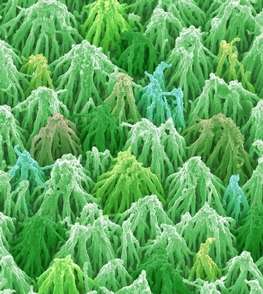Tiny Triffids march to Science Photography Competition's top prize

An image of a diamond-coated forest of carbon nanotubes that can act as miniature electron emitters, has won the overall prize in a national science photography competition organised by the Engineering and Physical Sciences Research Council (EPSRC).
'March of the Triffids', by Paul May, from the University of Bristol, shows carbon nanotubes, around 50,000 times smaller than the width of a human hair, that are joined to form structures that act as emitters for electrical current.
This false-colour electron microscope image stole the show ahead of many other stunning pictures, featuring research in action, in the EPSRC competition - now in its second year.
Paul May explained: "Carbon-nanotubes normally grow vertically upwards, like the bristles on a hairbrush, but in contact with water they clump together like wet hair to form 'tepee-like' structures with a pointy top. We deposited a very thin layer of diamond onto these to lock them into shape. They now form arrays of points, comprised of between 10-20 carbon nanotubes. When we apply a high voltage, electrons can travel up the nanotubes to the tip of the tepee and be emitted into a vacuum, where they can be made to strike a phosphor screen to give off light. This may result in display screens that last longer."
Explaining why he named the winning image 'March of the Triffids' Paul said: " I tried several different false-colour schemes in Photoshop, and when I tried green the tepee structures immediately reminded me of triffids, and hundreds of them together looked like an army on the march - hence the title."
The competition's five categories were: Discovery, Weird and Wonderful, Equipment, Innovation, and People.
Winning images feature:
- Beautiful 3D printed versions of mathematical constructs such as the Julia Set
- Electron microscope images of the cells within bamboo
- A nanometre-thick vapour cell used in atomic physics experiments that displays the interference patterns known as Newton's Rings
- A spookily-lit, animated 'brain in jar' to illustrated the effect of horror films on brain waves
- An iCub humanoid robot that will learn from infant development how to move and interact with its surroundings
Congratulating the winners and entrants, Professor Philip Nelson, EPSRC's Chief Executive, said: "The quality of the entries is testament to the talents, both scientific and artistic, of the people EPSRC supports.
"This competition and these truly inspirational images are a great way for us to engage with academics, connect the general public with research they fund, and inspire everyone to take an interest in science and engineering."
The competition received over 250 entries which were drawn from researchers in receipt of EPSRC funding. The judges were: Martin Keene, Group Picture Editor, Press Association; Lesley Thompson, EPSRC's Director of Science and Engineering and Graihagh Jackson producer for BBC Radio 5 Live's The Naked Scientists programme.
The first, second and third prize winning images with descriptions are all available to download from the EPSRC website http://www.epsrc.ac.uk
Provided by Engineering and Physical Sciences Research Council